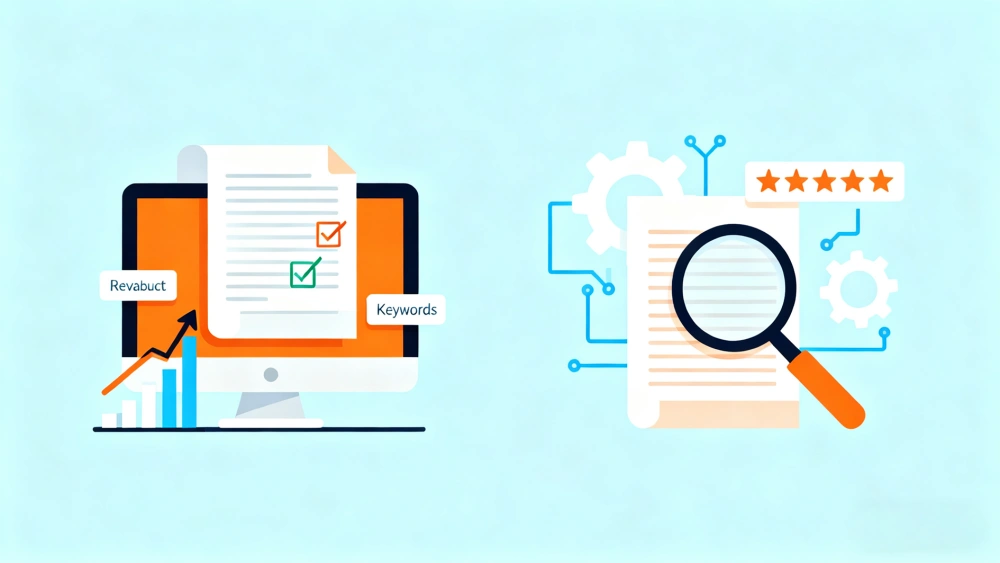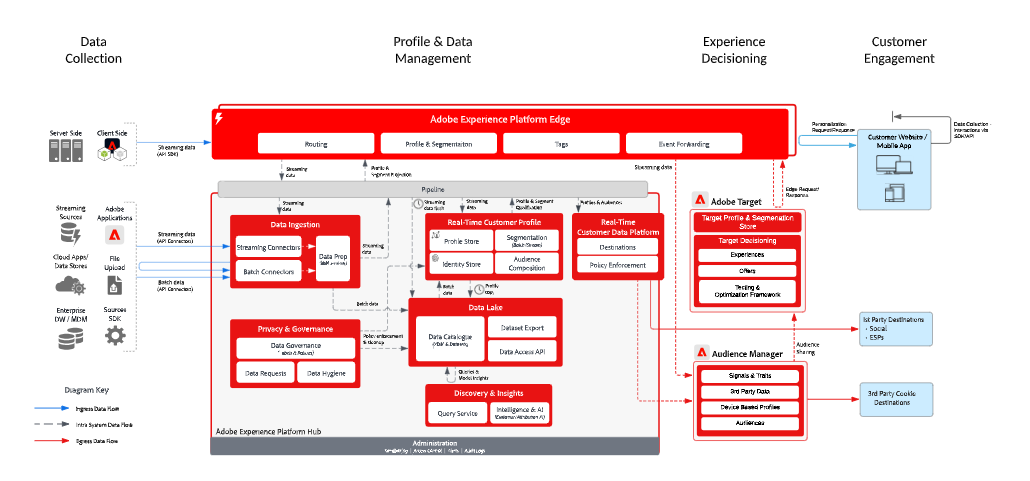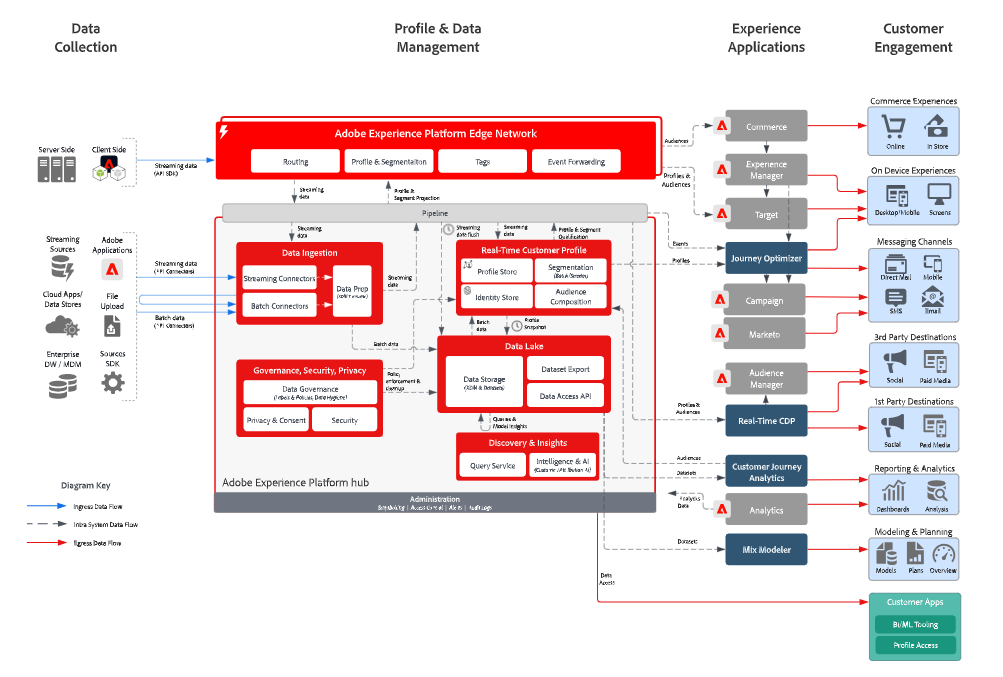
Practical Applications of AEP + RTCDP + AJO + CJA: Integration, Industry Use Cases, and Best Practices
Adobe Experience Platform & Realtime CDP, Adobe Journey Optimizer, CDP, Customer Journey Analytics
10 November 2025
- Introduction: Why Integration Across Adobe Experience Cloud Matters
- How the Adobe Stack Works Together
- End-to-End Customer Journey Example
- Industry Use Cases
- Best Practices for Successful Implementation
- Common Challenges and How to Overcome Them
- Conclusion: Unlocking Full Value with an Integrated Adobe Stack
- Introduction: Why Integration Across Adobe Experience Cloud Matters
- How the Adobe Stack Works Together
- End-to-End Customer Journey Example
- Industry Use Cases
- Best Practices for Successful Implementation
- Common Challenges and How to Overcome Them
- Conclusion: Unlocking Full Value with an Integrated Adobe Stack
1. Introduction: Why Integration Across Adobe Experience Cloud Matters
In the modern marketing landscape, brands face a growing challenge—fragmented MarTech stacks that isolate customer data across systems. These silos lead to disjointed experiences, inefficient campaigns, and limited insights into what truly drives engagement.
Adobe’s integrated ecosystem—Adobe Experience Platform (AEP), Real-Time Customer Data Platform (RTCDP), Adobe Journey Optimizer (AJO), and Customer Journey Analytics (CJA)—addresses this by unifying data, activation, and analytics under one framework. Together, they enable real-time personalization, continuous optimization, and measurable impact.
The result? A single source of truth for customer data, seamless journey orchestration, and data-driven decisions that enhance both customer experience and ROI.

2. How the Adobe Stack Works Together
Data Foundation with AEP
Adobe Experience Platform acts as the foundation, ingesting and standardizing data from all customer touchpoints—web, CRM, mobile apps, and offline transactions—into the Experience Data Model (XDM). Data is stored in a unified Data Lake and consolidated into Real-Time Customer Profiles, enabling brands to maintain accurate, up-to-date views of every individual.
Segmentation with RTCDP
With Adobe Real-Time CDP, marketers can build dynamic audiences based on real-time behaviors and attributes. Its powerful identity resolution merges anonymous and known data to create unified profiles, while segmentation tools allow for precise targeting—essential for delivering relevant messages at the right time.
Activation with AJO
Adobe Journey Optimizer operationalizes these insights by orchestrating personalized, cross-channel customer journeys. It connects email, SMS, LINE, and push notifications in one workflow, enabling marketers to deliver consistent and contextually relevant experiences across touchpoints.
Measurement with CJA
Finally, Customer Journey Analytics closes the loop by analyzing end-to-end performance. Through advanced attribution and visual journey analysis, CJA empowers businesses to understand how each touchpoint contributes to conversion, retention, and customer lifetime value.
Data Foundation with AEP
Adobe Experience Platform acts as the foundation, ingesting and standardizing data from all customer touchpoints—web, CRM, mobile apps, and offline transactions—into the Experience Data Model (XDM). Data is stored in a unified Data Lake and consolidated into Real-Time Customer Profiles, enabling brands to maintain accurate, up-to-date views of every individual.
Segmentation with RTCDP
With Adobe Real-Time CDP, marketers can build dynamic audiences based on real-time behaviors and attributes. Its powerful identity resolution merges anonymous and known data to create unified profiles, while segmentation tools allow for precise targeting—essential for delivering relevant messages at the right time.
Activation with AJO
Adobe Journey Optimizer operationalizes these insights by orchestrating personalized, cross-channel customer journeys. It connects email, SMS, LINE, and push notifications in one workflow, enabling marketers to deliver consistent and contextually relevant experiences across touchpoints.
Measurement with CJA
Finally, Customer Journey Analytics closes the loop by analyzing end-to-end performance. Through advanced attribution and visual journey analysis, CJA empowers businesses to understand how each touchpoint contributes to conversion, retention, and customer lifetime value.

3. End-to-End Customer Journey Example
Let’s visualize how the Adobe Experience Cloud works in practice:
Step 1: Collecting Data
Data flows into AEP from various sources—web interactions, CRM data, offline transactions, and mobile app events.
Step 2: Creating Audiences
RTCDP identifies and segments audiences such as high-value shoppers or churn-risk customers based on behavioral signals and lifecycle stage.
Step 3: Delivering Personalized Journeys
AJO delivers hyper-personalized communications—an abandoned cart email, a loyalty offer on LINE, or a reactivation push notification—all triggered in real time.
Step 4: Analyzing Effectiveness
CJA measures the effectiveness of these journeys, linking customer engagement data to conversion, retention, and ROI metrics. This creates a feedback loop that continually refines future campaigns.
Visual Guide Suggestion (for design team):
Create a flow diagram showing data ingestion (AEP) → audience segmentation (RTCDP) → journey activation (AJO) → analytics loop (CJA), highlighting customer touchpoints along the journey.
4. Industry Use Cases

Retail & E-commerce
Recover abandoned carts, promote loyalty offers, and personalize product recommendations using unified audience insights and real-time triggers.

Financial Services & Insurance
Leverage risk-based personalization to deliver next-best offers, guide customers through policy renewals, or support personalized advisory journeys.

Education
Enhance student recruitment with data-driven targeting, engage alumni with relevant updates, and personalize learning content for better student outcomes.

Real Estate & Property
Automate lead nurturing, launch project campaigns, and engage VIP clients with exclusive property insights through orchestrated multi-channel journeys.
5. Best Practices for Successful Implementation

Data Governance
Establish strong privacy and consent frameworks to ensure compliance with GDPR and CCPA.

Data Quality
Maintain clean, deduplicated, and well-structured profiles to support precise targeting and measurement.
Cross-Functional Collaboration
Align marketing, IT, analytics, and compliance teams to streamline implementation.
Incremental Rollout
Begin with a proof of concept (POC) and scale gradually as data integration and automation mature.
Measurement Discipline
Use CJA to continuously measure and optimize marketing performance based on concrete insights.
6. Common Challenges and How to Overcome Them
Identity Resolution Gaps
Bridge disconnected data sources using AEP’s identity graph for holistic profile building.
Legacy System Integration
Employ Adobe’s APIs and connectors to integrate with existing CRM, ERP, and POS systems.
Batch vs. Real-Time Data
Shift from delayed batch processes to event-based, real-time data ingestion for agility.
Skill Gaps
Invest in upskilling teams in data analytics, automation, and journey design to fully leverage Adobe’s capabilities.
7. Conclusion: Unlocking Full Value with an Integrated Adobe Stack
Integration across AEP, RTCDP, AJO, and CJA transforms fragmented marketing efforts into a cohesive, data-driven experience. When unified, these tools enable personalized customer engagement, actionable analytics, and measurable ROI.
Organizations that embrace this holistic Adobe ecosystem not only streamline their operations but also future-proof their customer experience strategy.
Next Up:
Stay tuned for: Future Trends: How AI and Adobe Experience Platform Are Powering the Next Generation of Personalization
Interested in learning how Adobe Experience Platform can help your business?
Contact our team for more details »


